





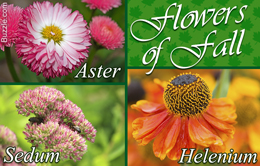 There are all kinds of fall flowers, but the best ones are those that do well in your very own backyard. The sunlight's just right and the weather couldn't have been more perfect. While the number of flowers collectively outnumber the days of the year, the best bunch grow just before winter comes rushing in. While fall flowers of all kinds are definitely worth a mention, I've picked out the season's finest offerings.Great Fall Flowers for GardensGardening is a definite hobby that practically anyone can take up, provided that you of course religiously follow the dos and don'ts of gardening. Reading online about how to care for plants while buying books on the same, will ensure that you have a garden thriving with the best produce or plants. The following fall flowers are an immensely pleasurable addition to any garden, given the fact that their colors are sure to spark comfort and well-being.
There are all kinds of fall flowers, but the best ones are those that do well in your very own backyard. The sunlight's just right and the weather couldn't have been more perfect. While the number of flowers collectively outnumber the days of the year, the best bunch grow just before winter comes rushing in. While fall flowers of all kinds are definitely worth a mention, I've picked out the season's finest offerings.Great Fall Flowers for GardensGardening is a definite hobby that practically anyone can take up, provided that you of course religiously follow the dos and don'ts of gardening. Reading online about how to care for plants while buying books on the same, will ensure that you have a garden thriving with the best produce or plants. The following fall flowers are an immensely pleasurable addition to any garden, given the fact that their colors are sure to spark comfort and well-being.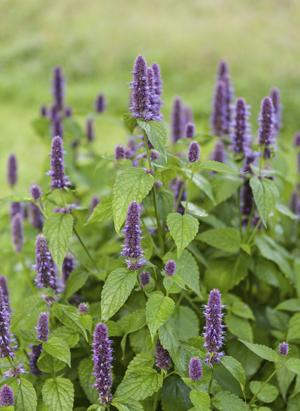 Anise HyssopThe agastache foeniculum is a pretty fall flower that is bluish lavender in color and comes in a host of other colors in white, pink, orange, and rose to name a few. Their fragrance is alluring, where their nectar draws a hoard of butterflies and hummingbirds. Be prepared to be pleasantly surprised by these winged beauties' presence in your backyard. These flowers are from the mint family, where the leaves' pattern give away their origin. The flower has a tangy flavor to its bite, where people actually crush it over fruit salad, either in its dried or fresh form. It's also used as a flavorful addition to tea preparations. Their scent falls between something like bubblegum and licorice.
Anise HyssopThe agastache foeniculum is a pretty fall flower that is bluish lavender in color and comes in a host of other colors in white, pink, orange, and rose to name a few. Their fragrance is alluring, where their nectar draws a hoard of butterflies and hummingbirds. Be prepared to be pleasantly surprised by these winged beauties' presence in your backyard. These flowers are from the mint family, where the leaves' pattern give away their origin. The flower has a tangy flavor to its bite, where people actually crush it over fruit salad, either in its dried or fresh form. It's also used as a flavorful addition to tea preparations. Their scent falls between something like bubblegum and licorice.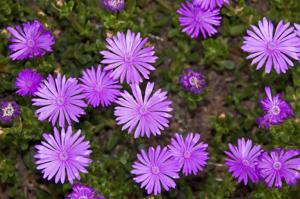 AsterThe aster novae-angliae is a petaled beauty that comes in other varieties of its kind in whites, blues, and pinks. Its name is derived from a Greek term that translates into 'star', given the flower head's shape. It comes with a yellow disk nestled within its center, where this particular variety of asters come in pale lavender or pink-tinged purple. This is another kind of flower that is a favorite of butterflies, where they thrive in partial or full-sun conditions. They're extremely easy to grow and do quite well during drought stricken conditions. Sunflowers are classified under the same group as asters (asteraceae), since their characteristic feature is their inflorescence.
AsterThe aster novae-angliae is a petaled beauty that comes in other varieties of its kind in whites, blues, and pinks. Its name is derived from a Greek term that translates into 'star', given the flower head's shape. It comes with a yellow disk nestled within its center, where this particular variety of asters come in pale lavender or pink-tinged purple. This is another kind of flower that is a favorite of butterflies, where they thrive in partial or full-sun conditions. They're extremely easy to grow and do quite well during drought stricken conditions. Sunflowers are classified under the same group as asters (asteraceae), since their characteristic feature is their inflorescence.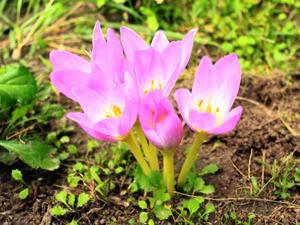 ColchicumThe colchicum autumnale is a bulb-shaped flower that comes in colors of whites and purples. Two names that this flower goes by will strike one as quite amusing - naked boys and naked ladies. The reason why these flowers are named so is because they take root from the ground first, before the leaves form. The entire plant along with its flowering has been termed as toxic upon consumption (colchinine - toxic alkaline substance). It's hard to believe how such a beautiful flower can be so poisonous. Nonetheless, it does come with a dose of good uses that doctors take advantage of.
ColchicumThe colchicum autumnale is a bulb-shaped flower that comes in colors of whites and purples. Two names that this flower goes by will strike one as quite amusing - naked boys and naked ladies. The reason why these flowers are named so is because they take root from the ground first, before the leaves form. The entire plant along with its flowering has been termed as toxic upon consumption (colchinine - toxic alkaline substance). It's hard to believe how such a beautiful flower can be so poisonous. Nonetheless, it does come with a dose of good uses that doctors take advantage of.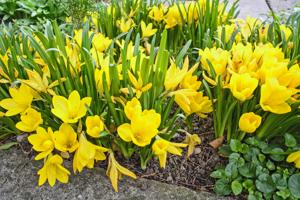 Fall CrocusUnlike the colchicum, the c. goulimyi is a dwarfed version of its counterpart. It has similar features - the bulb-shaped flowers and long tube structure that holds the leaves. These flowers peak through grassy fields, making them a unique sight to behold against a lush green backdrop. They carry a faint scent during early spring or autumn and come in shades of lilac and white. They're easy to grow in one's backyard and aren't in any way as toxic as their evil twin, the colchicum.
Fall CrocusUnlike the colchicum, the c. goulimyi is a dwarfed version of its counterpart. It has similar features - the bulb-shaped flowers and long tube structure that holds the leaves. These flowers peak through grassy fields, making them a unique sight to behold against a lush green backdrop. They carry a faint scent during early spring or autumn and come in shades of lilac and white. They're easy to grow in one's backyard and aren't in any way as toxic as their evil twin, the colchicum.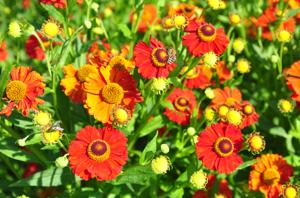 HeleniumThe helenium autumnale is an incredibly breathtaking flower to look at. The petals contain a fierce hue of orange-yellow and red (sometimes the flowers can be a plain yellow/red or a mix of orange and yellow) with a central deep brown protuberance that gives it an entirely eye-catching appearance. The foliage should be handled with care since some cases reported an allergic reaction upon contact. Nonetheless, it is safe to grow these flowers but must be avoided from consumtion. It's also termed 'sneezeweed' for its age-old use of crushing the leaves and using the powder as snuff. It was meant to drive away evil spirits once the person went into a fit of sneezes.
HeleniumThe helenium autumnale is an incredibly breathtaking flower to look at. The petals contain a fierce hue of orange-yellow and red (sometimes the flowers can be a plain yellow/red or a mix of orange and yellow) with a central deep brown protuberance that gives it an entirely eye-catching appearance. The foliage should be handled with care since some cases reported an allergic reaction upon contact. Nonetheless, it is safe to grow these flowers but must be avoided from consumtion. It's also termed 'sneezeweed' for its age-old use of crushing the leaves and using the powder as snuff. It was meant to drive away evil spirits once the person went into a fit of sneezes.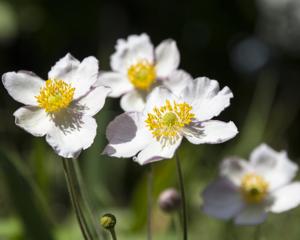 Japanese AnemoneThe anemone x hybrida is a small kind of flowering that comes in a palette of light pinks and pristine whites. The yellow shoots of stamen offset the soft backdrop of colors by adding a vibrant touch to the flower head. These pretty flowers grow well not just during the autumn season, but during summer and spring as well. Sometimes the petals are a blend of both pink and white with a touch of violet in some flowers. They grow in great numbers so taming this kind of rapid growth is essential in order to keep it away from other plants.
Japanese AnemoneThe anemone x hybrida is a small kind of flowering that comes in a palette of light pinks and pristine whites. The yellow shoots of stamen offset the soft backdrop of colors by adding a vibrant touch to the flower head. These pretty flowers grow well not just during the autumn season, but during summer and spring as well. Sometimes the petals are a blend of both pink and white with a touch of violet in some flowers. They grow in great numbers so taming this kind of rapid growth is essential in order to keep it away from other plants.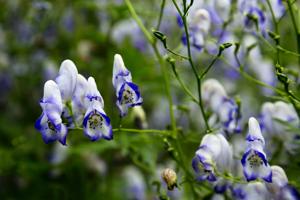 Monk's HoodThe aconitum carmichaelii is another toxic flower if ingested, but that shouldn't stop gardening enthusiasts from planting this indigo beauty in their backyard. Its petals are a beautiful swivel of blue and violet with a hooded look that is part of its arrangement. During the summers the petals turn a deep blue but are otherwise a mix of blue and violet - quite an attraction for onlookers. The toxin within the plant was once said to be used in making poisonous arrows.
Monk's HoodThe aconitum carmichaelii is another toxic flower if ingested, but that shouldn't stop gardening enthusiasts from planting this indigo beauty in their backyard. Its petals are a beautiful swivel of blue and violet with a hooded look that is part of its arrangement. During the summers the petals turn a deep blue but are otherwise a mix of blue and violet - quite an attraction for onlookers. The toxin within the plant was once said to be used in making poisonous arrows.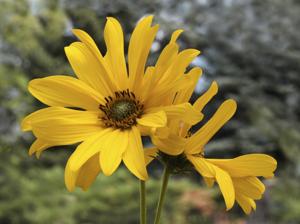 Perennial SunflowerThe helianthus 'Lemon Queen' is a lovely kind of sunflower that comes in a lemony hue with a central disk within its arrangement. The flower heads resemble those of daisies, looking absolutely breathtaking when in bloom. The good thing about growing this in your backyard is that you don't have to worry about it growing in a frenzied manner. This flower has been awarded the 'Award of Garden Merit' based on various criteria that makes it the ideal garden flower. Like many flowers in this list, the perennial sunflower is a much-loved plant amongst various gardening folk.
Perennial SunflowerThe helianthus 'Lemon Queen' is a lovely kind of sunflower that comes in a lemony hue with a central disk within its arrangement. The flower heads resemble those of daisies, looking absolutely breathtaking when in bloom. The good thing about growing this in your backyard is that you don't have to worry about it growing in a frenzied manner. This flower has been awarded the 'Award of Garden Merit' based on various criteria that makes it the ideal garden flower. Like many flowers in this list, the perennial sunflower is a much-loved plant amongst various gardening folk.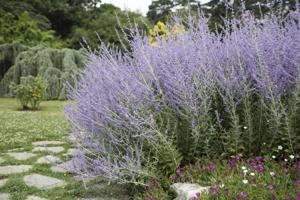 Russian SageThe perovskia atriplicifolia is a lovely wispy flowering plant that grows in wild clusters that look chaotically eye-pleasing. The tubular flowers are arranged along a stem that carries grayish-green leaves that come either as narrow lobes, or are shallow-toothed. The voilet-blue flowers are aromatic and grow to about 30cm tall and can reach a height of 1-1.4m. There are people who actually eat the flowers where others have used the leaves like tobacco. It is advised to grow this plant in tight clusters since they tend to sag when they acquire a certain height.
Russian SageThe perovskia atriplicifolia is a lovely wispy flowering plant that grows in wild clusters that look chaotically eye-pleasing. The tubular flowers are arranged along a stem that carries grayish-green leaves that come either as narrow lobes, or are shallow-toothed. The voilet-blue flowers are aromatic and grow to about 30cm tall and can reach a height of 1-1.4m. There are people who actually eat the flowers where others have used the leaves like tobacco. It is advised to grow this plant in tight clusters since they tend to sag when they acquire a certain height.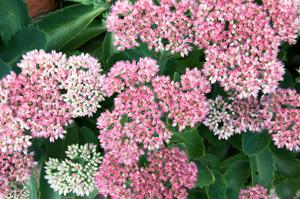 />SedumThe sedum spectabile is a plant of tightly clustered flowers that resemble enlarged broccoli florets from afar, in whites and vibrant or subtle shades of pink. These star-shaped flowers are picturesque in any garden, adding an effect like no other. The leaves are scalloped and broad with thick stems that hold the clusters of sedums. The plant thrives well during summer and autumn. They're favorites among butterflies and bees and are a welcome change to a garden that needs a spectacle to occupy its space. They have strange but amusing alternate names like brilliant stonecrop, ice plant, rabbit's cabbage, and showy stonecrop, to name a few.
/>SedumThe sedum spectabile is a plant of tightly clustered flowers that resemble enlarged broccoli florets from afar, in whites and vibrant or subtle shades of pink. These star-shaped flowers are picturesque in any garden, adding an effect like no other. The leaves are scalloped and broad with thick stems that hold the clusters of sedums. The plant thrives well during summer and autumn. They're favorites among butterflies and bees and are a welcome change to a garden that needs a spectacle to occupy its space. They have strange but amusing alternate names like brilliant stonecrop, ice plant, rabbit's cabbage, and showy stonecrop, to name a few.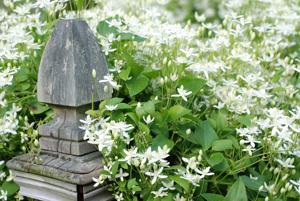 Sweet Autumn ClematisThe clematis terniflora is a deadly beauty (if ingested) and carries a striking array of white star-shaped flower heads that don't need to beg for attention. These flowers are actually vines that go berserk once they start to grow post being nurtured. They're low maintenance plants that require full to partial sunlight with adequate moisture to help them thrive. Beware though, they can grow out of control and take up a lot of space if not constantly contained. They're fragrance is sweet and powerful, and they make great plants for gardens with overhead arches or expansive ground space. Other varieties of the clematis are just as beautiful and worthy of any garden.
Sweet Autumn ClematisThe clematis terniflora is a deadly beauty (if ingested) and carries a striking array of white star-shaped flower heads that don't need to beg for attention. These flowers are actually vines that go berserk once they start to grow post being nurtured. They're low maintenance plants that require full to partial sunlight with adequate moisture to help them thrive. Beware though, they can grow out of control and take up a lot of space if not constantly contained. They're fragrance is sweet and powerful, and they make great plants for gardens with overhead arches or expansive ground space. Other varieties of the clematis are just as beautiful and worthy of any garden.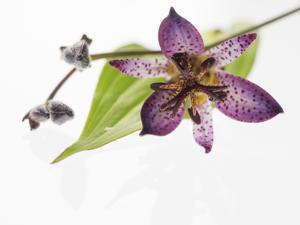 Toad LilyThe tricyrtis hirta is an Asian beauty that shouldn't be passed over when choosing a flower variety to grow. The flower heads are snow-white in color and covered in a pretty spread of violet spots. Their stigmas are also spotted with a tinge of pink bordering its ends. The tricyrtis hirta is surrounded by bits of sunflower yellow within the flower's throat, adding much character to its center. They're easy to take care of and require shaded protection (partial sun too) with well-drained, moist soil. There are remarkable varieties that this flower comes in which you can also look into.
Toad LilyThe tricyrtis hirta is an Asian beauty that shouldn't be passed over when choosing a flower variety to grow. The flower heads are snow-white in color and covered in a pretty spread of violet spots. Their stigmas are also spotted with a tinge of pink bordering its ends. The tricyrtis hirta is surrounded by bits of sunflower yellow within the flower's throat, adding much character to its center. They're easy to take care of and require shaded protection (partial sun too) with well-drained, moist soil. There are remarkable varieties that this flower comes in which you can also look into.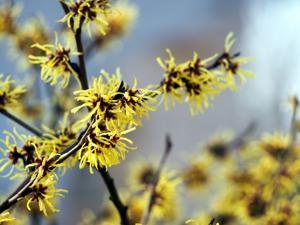 Witch HazelThe hamamelis virginiana is an odd flowering variety with thin, wispy flowers. They carry a lovely yellow color where they do well in partial sunlight to help it sustain itself. Places that don't experience frigid winter conditions can grow these in their garden, away from windy spots. They don't require a lot of pruning and can grow up to 20 feet tall. The colors change as the seasons shift, turning them into a heartwarming yellow as autumn melts into winter. It changes into other pretty colors of reds and oranges, where its strong fragrance is a welcome scent to any garden.
Witch HazelThe hamamelis virginiana is an odd flowering variety with thin, wispy flowers. They carry a lovely yellow color where they do well in partial sunlight to help it sustain itself. Places that don't experience frigid winter conditions can grow these in their garden, away from windy spots. They don't require a lot of pruning and can grow up to 20 feet tall. The colors change as the seasons shift, turning them into a heartwarming yellow as autumn melts into winter. It changes into other pretty colors of reds and oranges, where its strong fragrance is a welcome scent to any garden.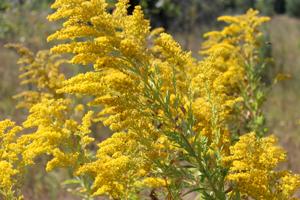 GoldenrodThe solidago rugosa shows off a brilliant display of mini flowers arranged in tapered clusters. Their showy display of sunshiny yellow is a treat for the senses and a great addition to any backyard. They harbor a number of visitors that come for its nectar, to build little homes, or to lay eggs. Goldenrods usually grow amok once planted, so choosing a hybrid is a better option - their growth is not only controlled but they're a shorter variety which is easier to take care of.
GoldenrodThe solidago rugosa shows off a brilliant display of mini flowers arranged in tapered clusters. Their showy display of sunshiny yellow is a treat for the senses and a great addition to any backyard. They harbor a number of visitors that come for its nectar, to build little homes, or to lay eggs. Goldenrods usually grow amok once planted, so choosing a hybrid is a better option - their growth is not only controlled but they're a shorter variety which is easier to take care of.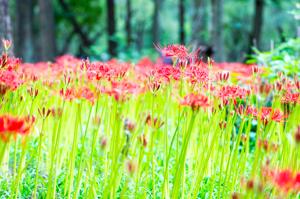 Red Spider LilyThe lycoris radiata although quite exquisite in its rich red color and spindly flowers, has been known through superstition as the bringer of death. While there is an aura of bleakness surrounding the notions that this flower symbolizes, it is nonetheless silly to not have these beauties in full bloom in your garden. Their appearance is not sinister nor hostile, but satisfying to look upon. They grow well after a heavy shower, sprouting from the ground after a abundant dose of water. The umbels that come forth along with the spider-like flowers is what makes it stand out.Flowers are nature's best assets when it comes to fall, so don't be afraid to experiment with varieties that do well in this season. Look up extensive ways on how to take care of these plants so that you can enjoy their presence for a long time.
Red Spider LilyThe lycoris radiata although quite exquisite in its rich red color and spindly flowers, has been known through superstition as the bringer of death. While there is an aura of bleakness surrounding the notions that this flower symbolizes, it is nonetheless silly to not have these beauties in full bloom in your garden. Their appearance is not sinister nor hostile, but satisfying to look upon. They grow well after a heavy shower, sprouting from the ground after a abundant dose of water. The umbels that come forth along with the spider-like flowers is what makes it stand out.Flowers are nature's best assets when it comes to fall, so don't be afraid to experiment with varieties that do well in this season. Look up extensive ways on how to take care of these plants so that you can enjoy their presence for a long time.
Copyright © www.100flowers.win Botanic Garden All Rights Reserved